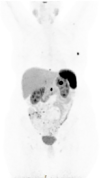Neuroendocrine liver metastases: a contemporary review of treatment strategies
- PMID: 32832495
- PMCID: PMC7423566
- DOI: 10.21037/hbsn.2020.04.02
Neuroendocrine liver metastases: a contemporary review of treatment strategies
Abstract
Well-differentiated neuroendocrine tumors (NETs) are globally increasing in prevalence and the liver is the most common site of metastasis. Neuroendocrine liver metastases (NELM) are heterogeneous in clinical presentation and prognosis. Fortunately, recent advances in diagnostic techniques and therapeutic strategies have improved the multidisciplinary management of this challenging condition. When feasible, surgical resection of NELM offers the best long-term outcomes. General indications for hepatic resection include performance status acceptable for major liver surgery, grade 1 or 2 tumors, absence of extrahepatic disease, adequate size and function of future liver remnant, and feasibility of resecting >90% of metastases. Adjunct therapies including concomitant liver ablation are generally safe when used appropriately and may expand the number of patients eligible for surgery. Among patients with synchronous resectable NELM, resection of the primary either in a staged or combined fashion is recommended. For patients who are not surgical candidates, liver-directed therapies such as transarterial embolization, chemoembolization, and radioembolization can provide locoregional control and improve symptoms of carcinoid syndrome. Multiple systemic therapy options also exist for patients with advanced or progressive disease. Ongoing research efforts are needed to identify novel biomarkers that will define the optimal indications for and sequencing of treatments to be delivered in a personalized fashion.
Keywords: Gastroenteropancreatic neuroendocrine tumors (GEP-NETs); carcinoid; hepatic resection; liver-directed therapies; targeted therapy.
2020 Hepatobiliary Surgery and Nutrition. All rights reserved.
Conflict of interest statement
Conflicts of Interest: All authors have completed the ICMJE uniform disclosure form (available at http://dx.doi.org/10.21037/hbsn.2020.04.02). TMP serves as an unpaid editorial board member of Hepatobiliary Surgery and Nutrition. The other authors have no conflicts of interest to declare.
Figures



Comment in
-
Neuroendocrine liver metastases treatment strategies: a viewpoint.Hepatobiliary Surg Nutr. 2021 Aug;10(4):561-563. doi: 10.21037/hbsn-21-178. Hepatobiliary Surg Nutr. 2021. PMID: 34430544 Free PMC article. No abstract available.
-
Surgical treatment for neuroendocrine liver metastasis: moving ahead in controversy.Hepatobiliary Surg Nutr. 2021 Dec;10(6):868-871. doi: 10.21037/hbsn-21-360. Hepatobiliary Surg Nutr. 2021. PMID: 35004957 Free PMC article. No abstract available.
References
-
- Rinke A, Müller HH, Schade-Brittinger C, et al. Placebo-controlled, double-blind, prospective, randomized study on the effect of octreotide lar in the control of tumor growth in patients with metastatic neuroendocrine midgut tumors: a report from the PROMID study group. J Clin Oncol 2009;27:4656-63. 10.1200/JCO.2009.22.8510 - DOI - PubMed
Publication types
LinkOut - more resources
Full Text Sources
